Rhode Island is a small state, yet it is home to a wide variety of birds. With its diverse habitats ranging from coastal marshlands to suburban yards and wooded areas, Rhode Island is home to over 200 species of birds.
From the iconic state bird, the Rhode Island Red Chicken, to the majestic Bald Eagle and the colorful Scarlet Tanager, Rhode Island has a plethora of birds to admire.
Whether you are a novice or an experienced birder, Rhode Island is a great place to explore and learn about the many species of birds that call the Ocean State home.
1. American Robin

The American robin is a migratory bird, belonging to the true thrush genus and Turdidae family.
It was named after its European counterpart due to the similar reddish-orange breast they both possess; however, they are not related closely.
This species can be seen through most of North America during winter months, as well as in parts of Mexico and Central America where it also breeds.
They have plump bodies with gray upperparts and white underparts that vary from yellow on their throats down to orange toward their bellies.
Robins feed on fruits such as berries or insects like worms which makes them an important part of ecosystems by helping disperse seeds naturally throughout these areas.
Scientific classification:
| Kingdom | Animalia |
| Phylum | Chordata |
| Class | Aves |
| Order | Passeriformes |
| Family | Turdidae |
| Genus | Turdus |
| Species | T. migratorius |
2. Northern Cardinal

The Northern Cardinal is a beautiful bird, easily identified by its bright red plumage. It can be found in the eastern United States from Maine to Minnesota and south through Mexico and Belize.
Along with its striking coloration, it has a distinctive crest on its head and sharp black facial markings around the eyes.
Despite their small size (measuring 7-9 inches), they are very vocal birds – males sing persistently throughout springtime to attract mates or proclaim their territory.
They typically feed on insects, seeds, and fruits but also enjoy suet at backyard bird feeders.
The female is less brightly colored than her mate but still stands out among other songbirds due to her warm brownish-red feathers.
Cardinals pair for life so you may often see them together in your garden or neighborhood park.
Scientific classification:
| Kingdom | Animalia |
| Phylum | Chordata |
| Class | Aves |
| Order | Passeriformes |
| Family | Cardinalidae |
| Genus | Cardinalis |
| Species | C. cardinalis |
3. Blue Jay

The Blue Jay is a beautiful bird that resides in the eastern and central United States, as well as Newfoundland Canada.
They have an unmistakable blue colored plumage with white markings on their heads and wings.
These birds are highly adaptable to different habitats ranging from deciduous forests to urban areas.
As part of the Corvidae family, they are known for being intelligent problem solvers who will often use tools or mimic vocalizations of other species like hawks when defending their territories.
Their diet consists mostly of insects, seeds, and nuts but can also include small vertebrates such as frogs or lizards if food resources become scarce.
Overall these birds provide much-needed color to our environment while playing important roles in maintaining healthy ecosystems through pollination services and seed dispersal activities.
Scientific classification:
| Kingdom | Animalia |
| Phylum | Chordata |
| Class | Aves |
| Order | Passeriformes |
| Family | Corvidae |
| Genus | Cyanocitta |
| Species | C. cristata |
4. House Finch

The House Finch is a species of finch native to western North America and has been introduced in the eastern half of the continent as well as Hawaii.
It’s an average-sized finch with adults measuring 12.5 – 15 cm (5 – 6 inches) long and having wingspans between 20 – 25 cm (8 – 10 inches).
The upperparts are brown, while its underparts range from pale grayish white to yellow depending on subspecies.
Its face is streaked or spotted with reddish coloration; males typically have brighter plumage than females due to sexual dimorphism.
They’re mostly found near human habitations such as farms and gardens where they feed on grains, fruits, insects etc., making them very popular among birders who want something colorful for their backyard.
Scientific classification:
| Kingdom | Animalia |
| Phylum | Chordata |
| Class | Aves |
| Order | Passeriformes |
| Family | Fringillidae |
| Subfamily | Carduelinae |
| Genus | Haemorhous |
| Species | H. mexicanus |
5. White-Breasted Nuthatch

The White-breasted Nuthatch is a medium-sized bird belonging to the nuthatch family Sittidae. It measures around 15.5 cm in length and its color varies throughout its range.
Males have a light blue-grey upperpart, with a black crown and nape whereas females have a dark grey crown instead of a black one.
The underparts are whitish, with reddish tinge on the sides and flanks while the bill is short and stout with a pale base near the eyes which can be yellow or white depending upon geographic location..
This species feeds mainly on insects but will also eat seeds, nuts, and berries when available.
They prefer open woodlands where they often climb trees searching for food along trunks as well as branches underneath bark crevices creating their nest there too.
Scientific classification:
| Kingdom | Animalia |
| Phylum | Chordata |
| Class | Aves |
| Order | Passeriformes |
| Family | Sittidae |
| Genus | Sitta |
| Species | S. carolinensis |
6. Black-Capped Chickadee

The black-capped chickadee is a small and cheerful songbird found in deciduous and mixed forests across North America. It has an iconic black cap, white cheeks, gray back and wings with whitish bars on them.
The underparts are usually light-colored or greyish-brown. This species is well adapted to cold winters as it can reduce its body temperature by up to 8°C while roosting at night; this helps save energy during the colder months of the year.
It feeds mainly on insects but also eats seeds, fruits, and suet from bird feeders when available.
Black-capped chickadees are popular birds among backyard visitors due to their sociable nature – they often establish lifelong partnerships with one another for breeding purposes.
Furthermore, they have been designated as state birds of Massachusetts and Maine in the USA plus New Brunswick in Canada – a testament to how beloved these little avian friends truly are.
Scientific classification:
| Kingdom | Animalia |
| Phylum | Chordata |
| Class | Aves |
| Order | Passeriformes |
| Family | Paridae |
| Genus | Poecile |
| Species | P. atricapillus |
7. Tufted Titmouse

The Tufted Titmouse is a small, cheerful songbird found in North America. It’s part of the tit and chickadee family (Paridae).
It has distinctive white feathers around its eyes, grey-brown wings, and upper body, with a pale tan underside.
Its most notable feature is the black crest on top of its head which gives it an inquisitive look. The male also sports a pinkish breast which can be seen.
When singing from high perches during the spring months. This bird loves to eat sunflower seeds or suet at backyard feeders as well as insects in summertime.
You may even see them poking into crevices and bark looking for food.
They are quite social birds too, being often spotted in mixed flocks alongside other species such as nuthatches and woodpeckers all year round.
Scientific classification:
| Kingdom | Animalia |
| Phylum | Chordata |
| Class | Aves |
| Order | Passeriformes |
| Family | Paridae |
| Genus | Baeolophus |
| Species | B. bicolor |
8. Downy Woodpecker
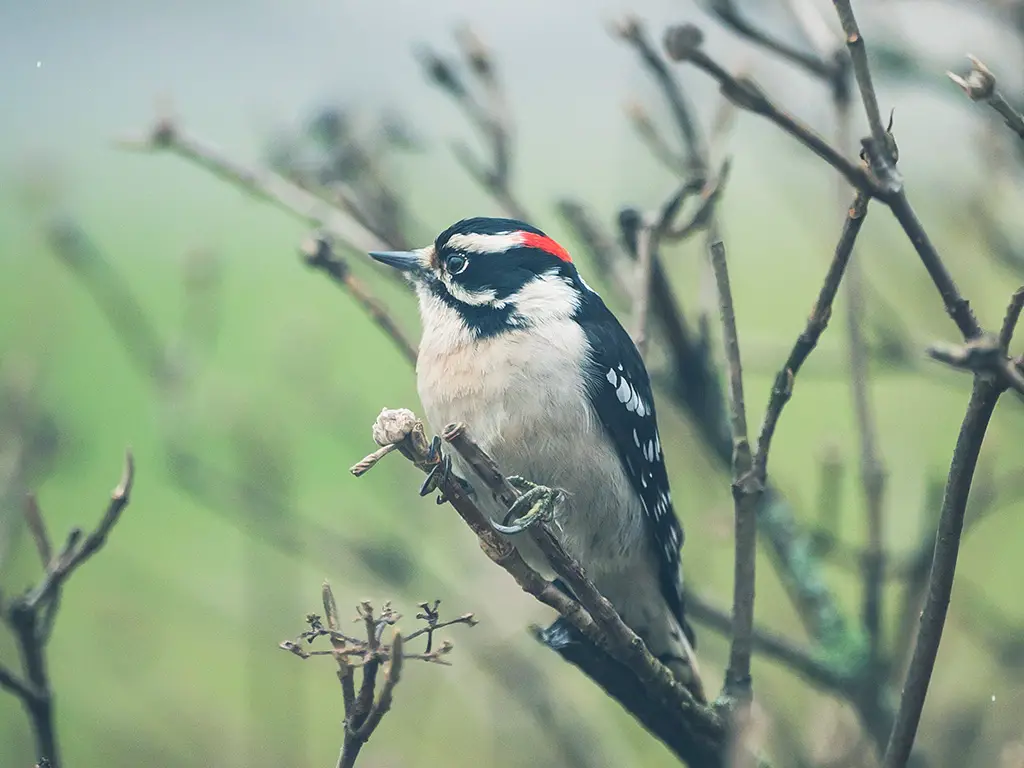
The downy woodpecker is a small species of woodpecker found in North America. Growing up to 7 inches long, it can be identified by its white belly and spotted wings.
It inhabits forests throughout the United States and Canada, except deserts in the southwest and northern tundra.
This bird nests in tree cavities and feeds mostly on insects but will supplement its diet with fruit or nuts when available.
The Downy Woodpecker has an unmistakable call that sounds like a loud ‘piker’, similar to other members of its family such as the Hairy Woodpecker.
Scientific classification:
| Kingdom | Animalia |
| Phylum | Chordata |
| Class | Aves |
| Order | Piciformes |
| Family | Picidae |
| Genus | Dryobates |
| Species | D. pubescens |
9. Red-Winged Blackbird

The red-winged blackbird is a beautiful bird found in most of North America and Central America.
Its distinct features include a glossy black body, with white shoulder patches and bright red wing coverts year round.
It prefers wetland habitats such as marshes, ponds, lakeshores, and agricultural fields. During breeding season they inhabit grassy areas near water then move south for the winter months.
For food, they mainly eat insects but also consume wild fruit or grains.
They are very social birds often seen in large flocks during migration times when their unmistakable “conk-la-ree” call can be heard echoing across the sky.
Scientific classification:
| Kingdom | Animalia |
| Phylum | Chordata |
| Class | Aves |
| Order | Passeriformes |
| Family | Icteridae |
| Genus | Agelaius |
| Species | A. phoeniceus |
10. Song Sparrow

The Song Sparrow (Melospiza melodia) is a small, yet abundant bird found in North America.
They have brown upperparts with dark streaks and are white underneath, complete with a distinct dark brown spot on the breast.
Their cap is also brown and long roughed feathers can be seen sprouting from their neck area.
This sparrow species is highly variable and adaptable to many different environments including dry brush land, wetlands, or open fields.
It has been noted that adult song sparrows will sing even during winter months when other birds remain quiet.
These energetic little animals make for great backyard companions as they flit about singing their lovely melodies.
Scientific classification:
| Kingdom | Animalia |
| Phylum | Chordata |
| Class | Aves |
| Order | Passeriformes |
| Family | Passerellidae |
| Genus | Melospiza |
| Species | M. melodia |
11. Common Grackle

The Common Grackle is a large icterid bird commonly found in North America. It has an iridescent head and pale yellow eyes, which are framed by its long dark bill and long tail.
Males typically have more vivid colors on their heads than females do. These birds can be seen across much of the continent, in fields, forests, wetlands – even urban areas.
They form huge flocks to search for food such as grains or insects that they catch with their bills.
The grackles may also scavenge from human sources like garbage dumps or picnic tables if available. With its colorful plumage and distinct call it’s easy to spot this species amongst other birds.
Scientific classification:
| Kingdom | Animalia |
| Phylum | Chordata |
| Class | Aves |
| Order | Passeriformes |
| Family | Icteridae |
| Genus | Quiscalus |
| Species | Q. quiscula |
12. White-Throated Sparrow

The White-throated Sparrow is a small passerine bird of the New World sparrow family Passerellidae.
It has distinctive yellow and black stripes on its head, white throat, and chest with grey back and wings, along with light brown legs.
The scientific name “Zonotrichia albicollis” comes from Ancient Greek for ‘band’ (ζώνη) referring to its distinctive striped crown, and Latin for ‘white neck’ (albus collum).
These birds are usually found in wooded areas such as coniferous forests or deciduous habitats in North America where they feed mainly on insects during summer months; transitioning to seeds during winter.
They build their nests near ground level using grasses, twigs, or moss lined with feathers.
White-throated Sparrows may be solitary but also form flocks when migrating southward each fall season which typically occurs over mid-late October through November depending on location within range.
Scientific classification:
| Kingdom | Animalia |
| Phylum | Chordata |
| Class | Aves |
| Order | Passeriformes |
| Family | Passerellidae |
| Genus | Zonotrichia |
| Species | Z. albicollis |
13. Gray Catbird
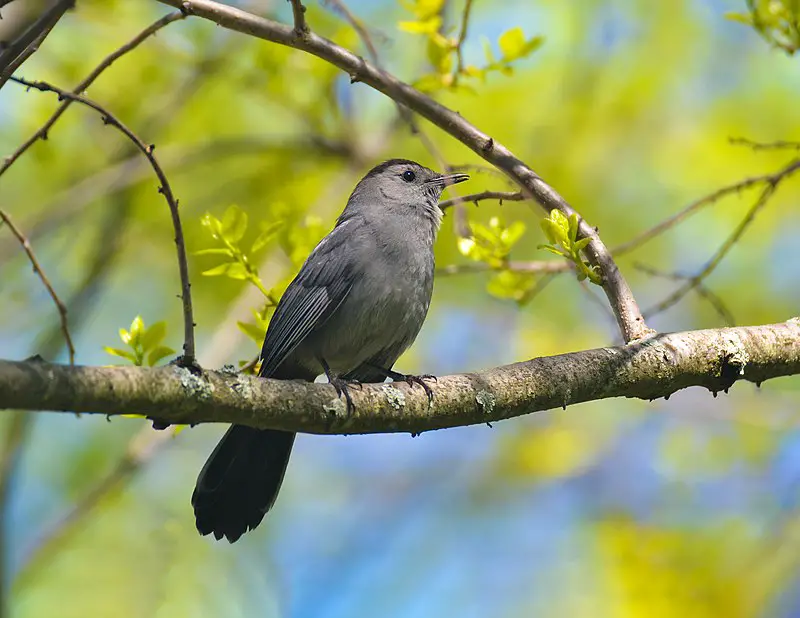
The Gray Catbird is a medium-sized bird native to North and Central America. It is the only species in its genus, Dumetella, which makes it unique among other perching birds of the Mimidae family.
Its plumage features shades of gray with some brownish tones on top and lighter grey below.
The underside of its tail has white feathers that contrast against its otherwise monochromatic coloration; this feature gives it its name as it often flicks its tail when alarmed or excited like cats do.
They are omnivorous but mainly feed on insects such as caterpillars, grasshoppers, and beetles while also eating fruits like berries or cherries during the summer months.
Despite being commonly seen alone or in pairs these birds will flock together at times for protection from predators like hawks who are drawn to their dark coloration against green foliage making them harder to spot.
Scientific classification:
| Kingdom | Animalia |
| Phylum | Chordata |
| Class | Aves |
| Order | Passeriformes |
| Family | Mimidae |
| Genus | Dumetella C.T. Wood, 1837 |
| Species | D. carolinensis |
14. Ruby-Throated Hummingbird

The ruby-throated hummingbird (Archilochus colubris) is a species of hummingbird that has an impressive migration pattern, spending the winter in Central America, Mexico, and Florida before flying to Canada and other parts of Eastern North America for the breeding season.
It’s by far the most common type seen east of the Mississippi River in North America.
Formally described by Swedish naturalist Carl Linnaeus in 1758, this tiny bird has bright metallic green upperparts with white underparts, a small black bill, and a red throat patch which gives it its name; they measure around 3 inches long on average.
They feed primarily on nectar from flowers but also eat insects such as flies or mosquitoes for extra protein during their migrations or when raising young chicks.
Scientific classification:
| Kingdom | Animalia |
| Phylum | Chordata |
| Class | Aves |
| Order | Apodiformes |
| Family | Trochilidae |
| Genus | Archilochus |
| Species | A. colubris |
15. Dark-Eyed Junco

The Dark-eyed Junco is a species of small, grayish sparrows that are found across much of temperate North America and in the Arctic during summer.
It was formally described by Carl Linnaeus in 1766, who named it after its distinctive dark eyes.
This bird has a very variable appearance due to the many different subspecies it contains, making its systematics difficult to unravel.
The plumage varies from white or light gray on their underparts with slate grey backs and wings; black heads with white outer tail feathers; brown head stripes; yellow bills; pink legs and feet; as well as various shades between all these colours.
They also have considerable sexual dimorphism where males tend to be more colorful than females but share similar characteristics such as short tails and rounded bodies – both sexes being around 16 cm long when fully grown.
Scientific classification:
| Kingdom | Animalia |
| Phylum | Chordata |
| Class | Aves |
| Order | Passeriformes |
| Family | Passerellidae |
| Genus | Junco |
| Species | J. hyemalis |
16. Baltimore Oriole
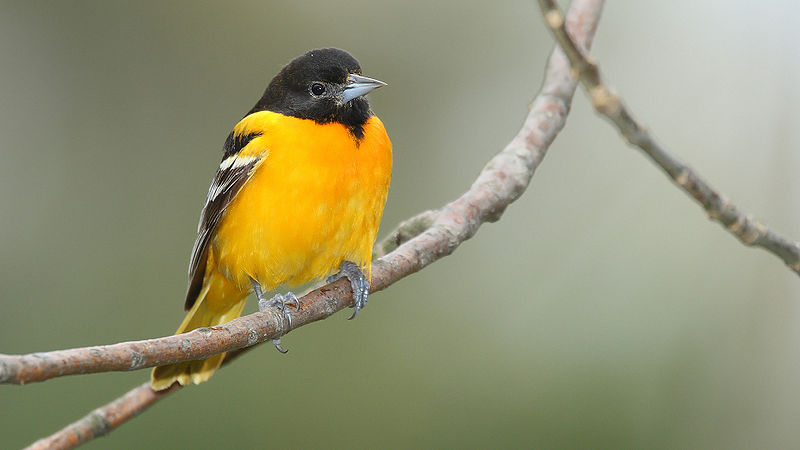
The Baltimore Oriole is a small, blackbird-like bird found in eastern North America. It’s named for the resemblance of its male colors to those on Lord Baltimore’s coat-of-arms from the 17th century.
These birds migrate and breed during springtime and are quite common in their habitats.
Studies have shown that this species interbreeds with western Bullock’s orioles, leading both to be classified as a single species – Icterus galbula.
The males typically have orange feathers along the chest, back, wings, and tail while females display tan or yellowish shades instead of bright orange ones like males do.
Both sexes share white wing bars and dark brown eyes which makes them easily distinguishable among other birds.
They can often be seen flitting around trees feeding off nectar buds or insects such as grasshoppers & caterpillars they catch while flying around.
Scientific classification:
| Kingdom | Animalia |
| Phylum | Chordata |
| Class | Aves |
| Order | Passeriformes |
| Family | Icteridae |
| Genus | Icterus |
| Species | I. galbula |
17. American Yellow Warbler
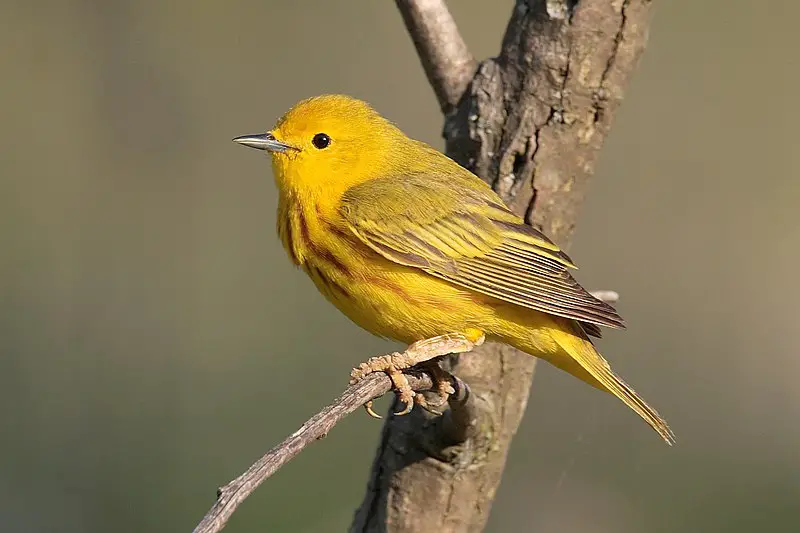
The American Yellow Warbler (Setophaga petechia) is a species of New World warbler found across North America, the Caribbean, and into northern South America.
Its genus name Setophaga comes from Ancient Greek words meaning “moth” and “eating”, while its specific name Petechia originates from Italian for small red spots.
This bird has striking yellow plumage with reddish-brown streaks on their chest that can be seen during mating season when they are most colorful.
They live in open woodlands near wetlands or bodies of water where they can find food such as insects like spiders, beetles, and caterpillars which make up much of their diet.
The male will sing to attract a mate during the breeding season before setting up a home in twig nests built by both sexes together high in trees or shrubs.
Scientific classification:
| Kingdom | Animalia |
| Phylum | Chordata |
| Class | Aves |
| Order | Passeriformes |
| Family | Parulidae |
| Genus | Setophaga |
| Species | S. petechia |
18. American Crow

The American crow is a large bird of the Corvidae family, native to most parts of North America.
It is similar in size and structure to its European counterpart, the carrion crow, as well as Eurasia’s hooded crow.
The three species occupy the same ecological niche but are distinguishable by their differences in appearance.
American crows have black feathers covering their entire body with wingspan averaging between 17-21 inches wide for males and 16-19 inches for females.
They feed on insects such as grasshoppers, beetles, and caterpillars; they also eat grains from fields or abandoned farms during winter months when food sources become scarcer.
In addition to feeding habits, American crows can be identified by their distinct call which resembles a “caw” sound that travels long distances over open terrain making them popular among birdwatchers.
Scientific classification:
| Kingdom | Animalia |
| Phylum | Chordata |
| Class | Aves |
| Order | Passeriformes |
| Family | Corvidae |
| Genus | Corvus |
| Species | C. brachyrhynchos |
19. Northern Mockingbird
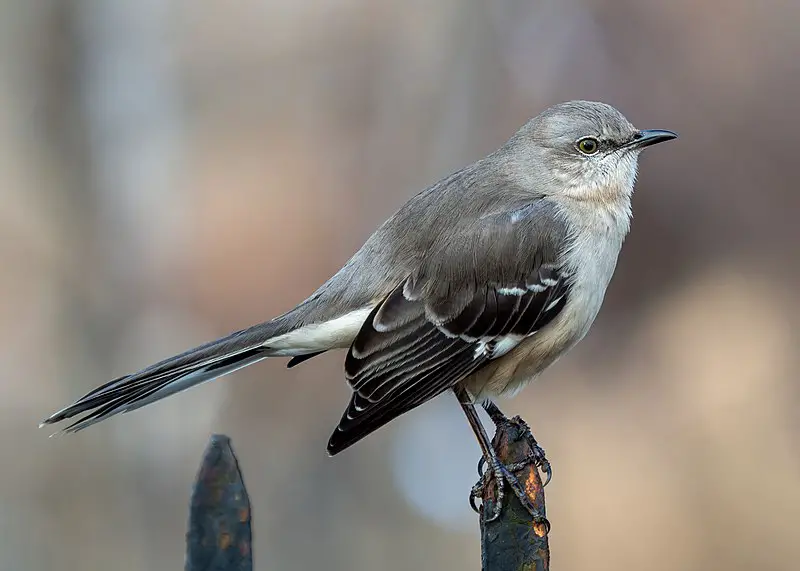
The northern mockingbird is a common fixture in North American skies. It has greyish-brown upperparts and a paler underside with white wing patches, and its distinctive long tail makes it easy to spot.
This adaptable bird can often be seen singing from the tops of trees or fences, though it rarely strays into Europe.
The species was first described by Carl Linnaeus in his 1758 Systema Naturae as Turdus polyglottos – aptly named for their remarkable ability to mimic other birds’ songs.
Northern mockingbirds typically live on insects, fruits, berries, and seeds but they will also happily scavenge food scraps left out by humans.
With its beautiful song and striking plumage, this beloved avian makes an important contribution to our environment.
Scientific classification:
| Kingdom | Animalia |
| Phylum | Chordata |
| Class | Aves |
| Order | Passeriformes |
| Family | Mimidae |
| Genus | Mimus |
| Species | M. polyglottos |
20. Red-Tailed Hawk
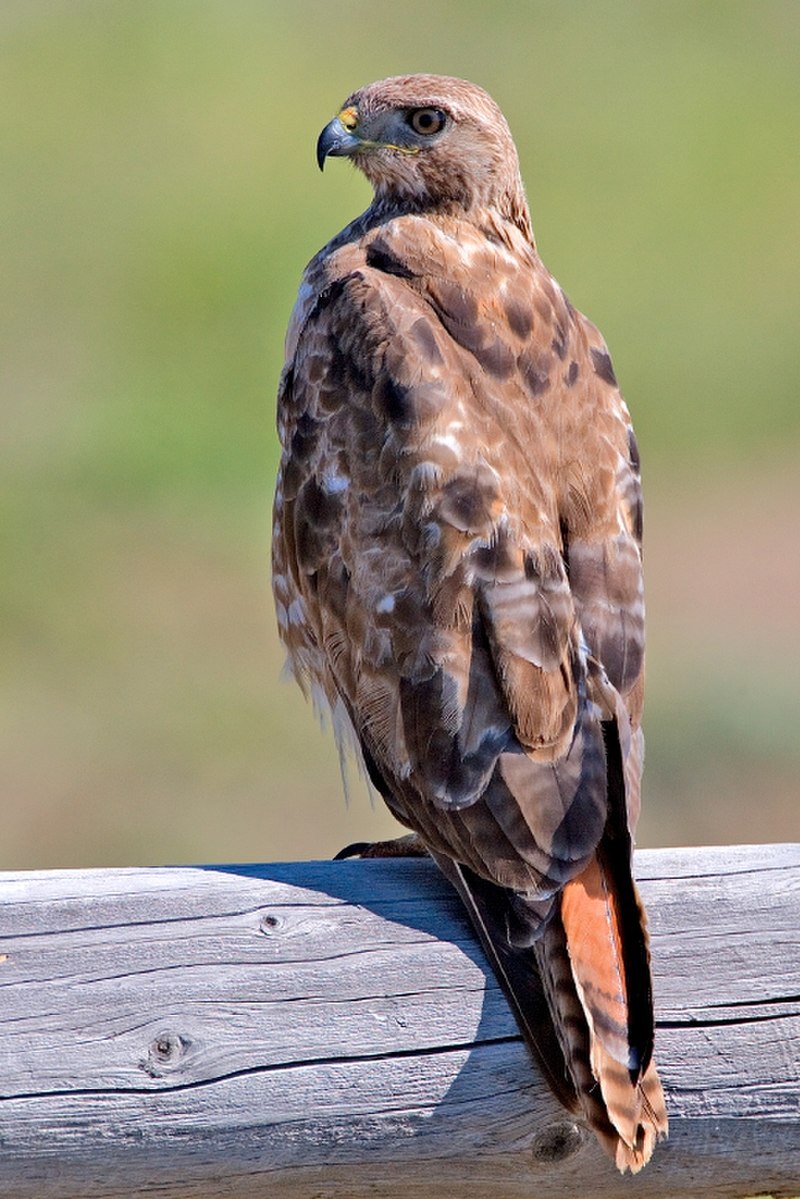
The Red-tailed Hawk is a majestic bird of prey with a distinctive red tail. It can be found throughout North America, from Alaska in the north to Panama and the West Indies in the south.
This species belongs to the Buteo genus, which makes it one of the most common raptors on Earth.
These hawks mainly hunt small mammals such as rabbits or squirrels but also feed on reptiles and birds during migration season.
Unlike other predator birds, they prefer open areas for hunting like fields or grasslands rather than dense forests.
They build their nests high up on trees where they stay all year long unless disturbed by humans or animals nearby.
Their presence has become an iconic part of American culture due to their frequent sightings around homes and parks alike making them beloved creatures among people everywhere.
Scientific classification:
| Kingdom | Animalia |
| Phylum | Chordata |
| Class | Aves |
| Order | Accipitriformes |
| Family | Accipitridae |
| Genus | Buteo |
| Species | B. jamaicensis |
21. Carolina Wren
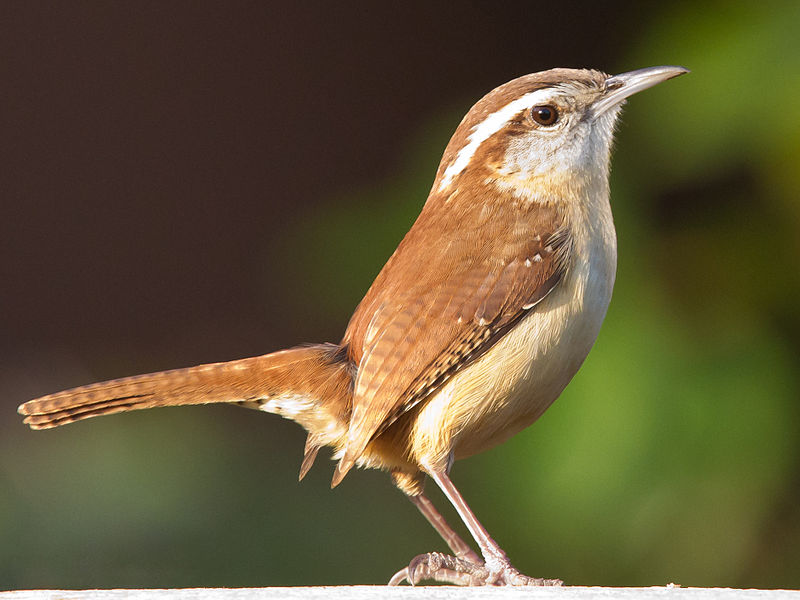
The Carolina wren (Thryothorus ludovicianus) is a medium-sized bird that can be found in the eastern United States, southern Ontario, and northeast Mexico.
They typically live in dense shrubbery or thickets near open areas such as gardens, parks, and woodland edges.
These birds are quite adaptable when it comes to nesting sites – they will build their nests anywhere from tree cavities to manmade boxes.
Their diet consists of insects, spiders, and other invertebrates which they forage for on the ground or among vegetation.
The males have an unmistakable song made up of loud whistles interspersed with trills reminiscent of laughter; you’ll often find these cheerful little birds singing away during early morning hours.
Scientific classification:
| Kingdom | Animalia |
| Phylum | Chordata |
| Class | Aves |
| Order | Passeriformes |
| Family | Troglodytidae |
| Genus | Thryothorus Vieillot, 1816[2] |
| Species | T. ludovicianus |
22. Cooper’s Hawk
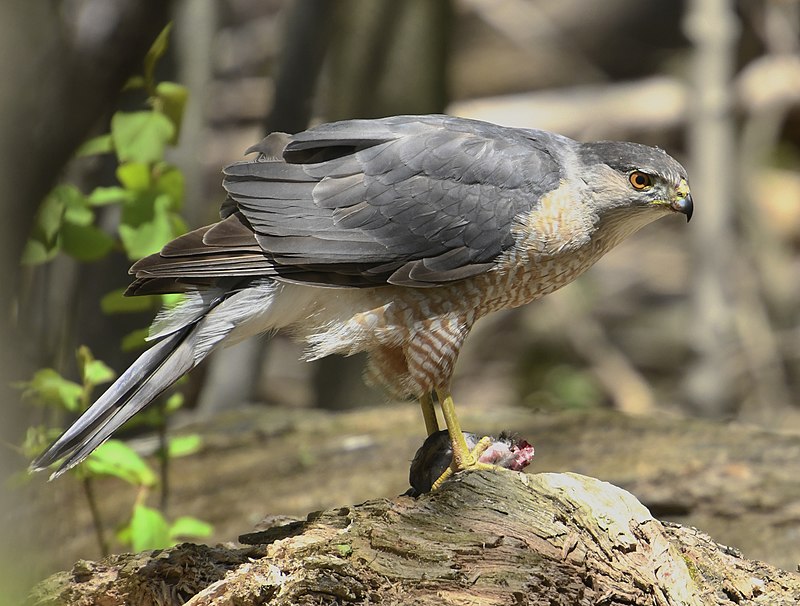
Cooper’s Hawk is a medium-sized bird of prey native to North America. It belongs to the Accipiter genus, which is known for its agility and small size compared to other hawks.
They usually inhabit wooded areas, making them well-adapted hunters in dense environments.
Cooper’s Hawks have rounded wings with short tails that help them maneuver quickly through trees when chasing after prey such as small rodents or birds.
These raptors also possess powerful feet equipped with sharp talons used for catching food items on the ground and even out of midair.
The adult plumage has barred upperparts, ranging from greyish brown on lighter individuals up to dark chestnut colors found in darker specimens; they also display rusty underparts marked by thin white streaking down either side of their chests and bellies.
Scientific classification:
| Kingdom | Animalia |
| Phylum | Chordata |
| Class | Aves |
| Order | Accipitriformes |
| Family | Accipitridae |
| Genus | Accipiter |
| Species | A. cooperii |
23. Blue-Winged Warbler
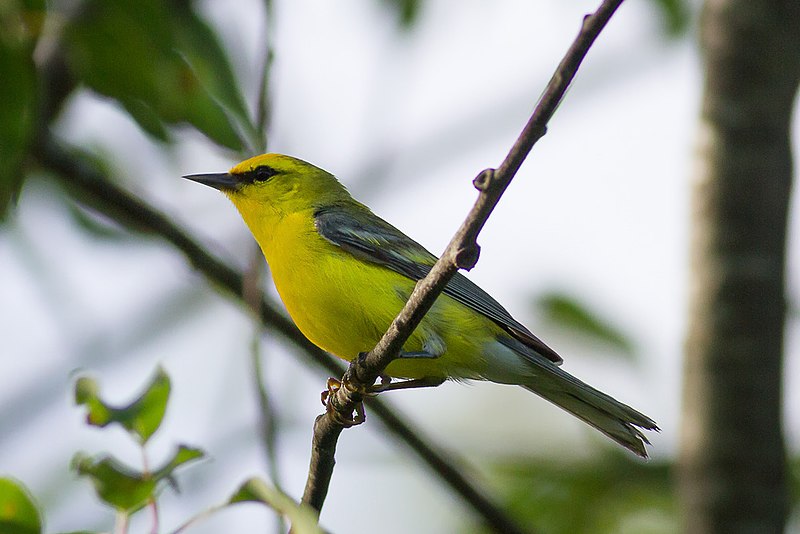
The Blue-winged Warbler is a common species of New World warbler, measuring 11.5 cm (4.5 in) long and weighing 8.5 g (0.30 oz).
It breeds mainly in eastern North America from southern Ontario to the US east coast, with its range gradually expanding northwards as it replaces its closely related cousin – the Golden-winged Warbler – in these parts of the world.
The name “Blue-winged” refers to its distinctive blue wings which contrast sharply against an olive green body plumage and white underparts scattered with yellow spots or streaks on either side of the breast region.
Males often have brighter colors than females do during breeding season, while nonbreeding birds tend to be duller overall regardless of sex difference.
Its diet consists mostly of insect prey items such as caterpillars, beetles & moths that are gleaned off foliage or caught midflight by this active forager.
Scientific classification:
| Kingdom | Animalia |
| Phylum | Chordata |
| Class | Aves |
| Order | Passeriformes |
| Family | Parulidae |
| Genus | Vermivora |
| Species | V. cyanoptera |
Also Featured In: Birds in Iowa Spring, Yellow Connecticut Birds
24. Rusty Blackbird
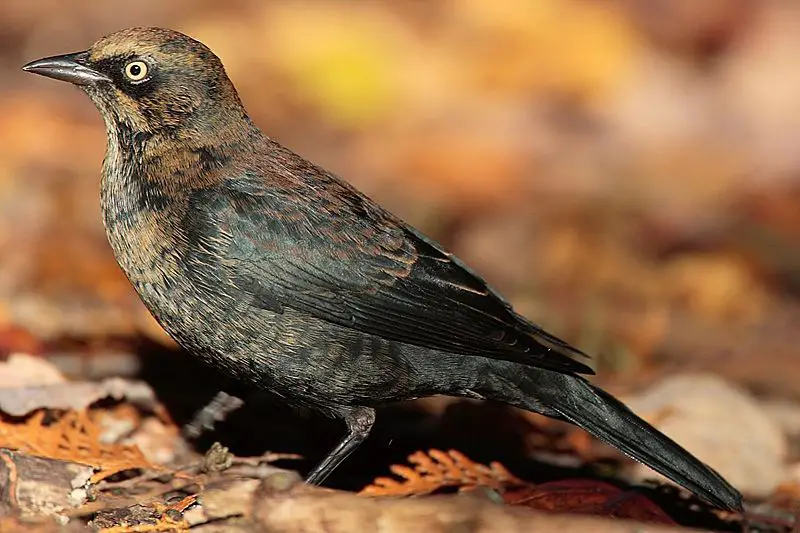
The Rusty Blackbird is a medium-sized member of the New World blackbird family. It breeds in wet forested areas and boreal forests across northern Canada and then migrates southeast to winter in the United States.
Sadly, this species has suffered one of the most dramatic population declines ever recorded amongst North American bird species – their numbers have been reduced by 90% since 1970.
Fortunately, conservation efforts are underway to help reverse this trend and protect these birds for future generations.
They are now largely found around wetlands with thick vegetation cover that provides food sources such as berries, seeds, or insects during migration periods.
Scientific classification:
| Kingdom | Animalia |
| Phylum | Chordata |
| Class | Aves |
| Order | Passeriformes |
| Family | Icteridae |
| Genus | Euphagus |
| Species | E. carolinus |
Also Featured In: Birds that Live in Newfoundland and Labrador, Common Northwest Territories Birds
25. Eastern Bluebird
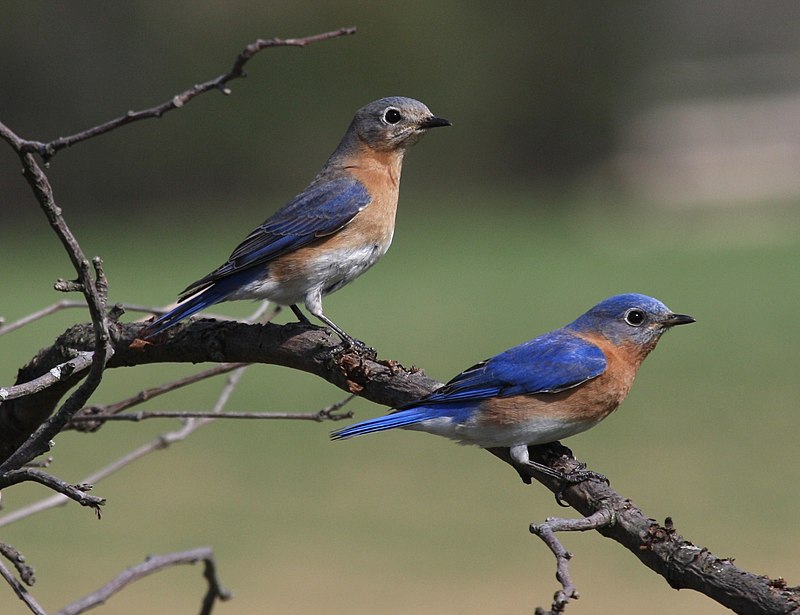
The Eastern bluebird is a small migratory thrush that can be found in open woodlands, farms, and orchards across North America.
The male has bright-blue breeding plumage which makes it easily recognizable by birders.
It produces melodious songs such as jeew, chir-wi, and chiti WEEW wewidoo.
This popular species was declared the state bird of Missouri back in 1927 due to its beauty and charm.
In addition to being beautiful, these birds are also beneficial for farmers because they eat insects like grasshoppers and beetles which damage crops.
They nest in cavities so providing nesting boxes helps them thrive even more.
With their vibrant colors, sweet melodies, and helpful nature it’s easy to see why the Eastern Bluebird is beloved worldwide.
Scientific classification:
| Kingdom | Animalia |
| Phylum | Chordata |
| Class | Aves |
| Order | Passeriformes |
| Family | Turdidae |
| Genus | Sialia |
| Species | S. sialis |
26. Snowy Egret
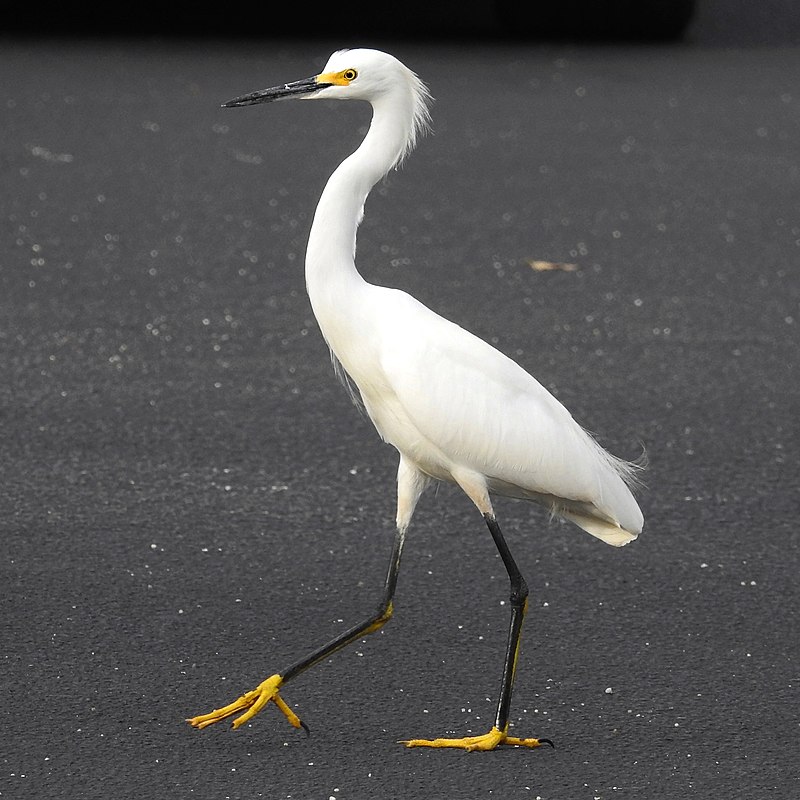
The Snowy Egret is a small white heron native to North America. Its scientific name, Egretta thula, comes from Provençal French for the little egret and an incorrect reference to the Black-necked Swan by Chilean naturalist Juan Ignacio Molina in 1782.
This beautiful bird has black legs yellow feet, and a long plume of feathers on its head that often appears as if it’s wearing a crown.
It feeds primarily on insects and aquatic life like fish or frogs making it well adapted for both wetland habitats such as marshes or swamps plus coastal areas close to shorelines.
With their graceful movements, they are truly delightful creatures to observe while out exploring nature.
Scientific classification:
| Kingdom | Animalia |
| Phylum | Chordata |
| Class | Aves |
| Order | Pelecaniformes |
| Family | Ardeidae |
| Genus | Egretta |
| Species | E. thula |
27. Great Blue Heron

The Great Blue Heron is a majestic wading bird found in many parts of North America, Central America, the Caribbean, and even as far away as the Galapagos Islands.
It has an impressive wingspan which can reach up to six feet wide. Its feathers are mainly bluish-gray with brownish streaks on both its neck and chest while its head displays white plumes.
The adult herons can also be identified by their yellow bill and legs.
They live near bodies of water such as lakes, marshes, or rivers where they feed on fish using a spear-like motion with their sharp bills.
An all-white population exists only in South Florida and the Florida Keys making it unique.
Scientific classification:
| Kingdom | Animalia |
| Phylum | Chordata |
| Class | Aves |
| Order | Pelecaniformes |
| Family | Ardeidae |
| Genus | Ardea |
| Species | A. herodias |
28. Canada Goose
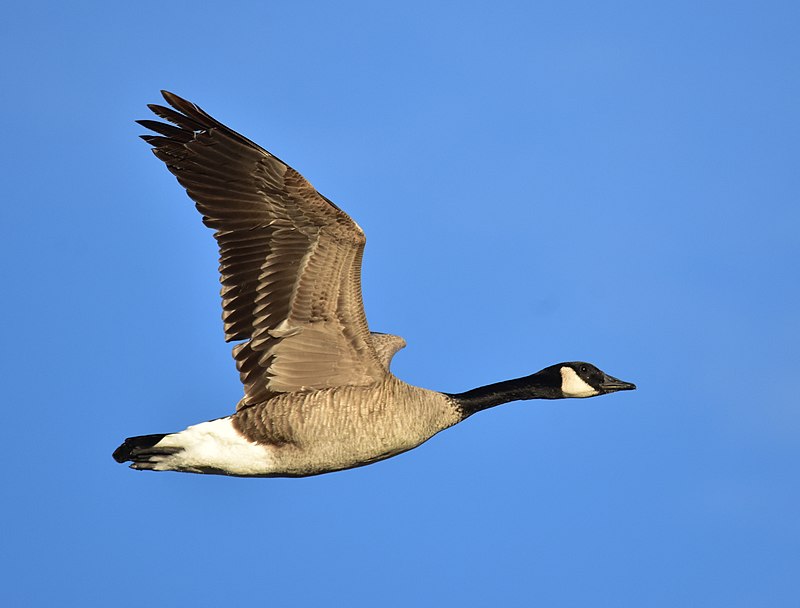
The Canada goose is a majestic bird with a black head and neck, white cheeks, chin, and brown body. It’s native to North America but occasionally migrates to northern Europe across the Atlantic.
The species has been introduced in the United Kingdom, Ireland, and Finland as well. Canada geese are strong flyers that travel in flocks for protection from predators; they also form monogamous pairs for life.
They feed on grasses or grains near ponds or wetlands where they make their nests of down which incubate eggs during summertime before hatching them out into goslings later on.
Scientific classification:
| Kingdom | Animalia |
| Phylum | Chordata |
| Class | Aves |
| Order | Anseriformes |
| Family | Anatidae |
| Genus | Branta |
| Species | B. canadensis |
29. Chipping Sparrow
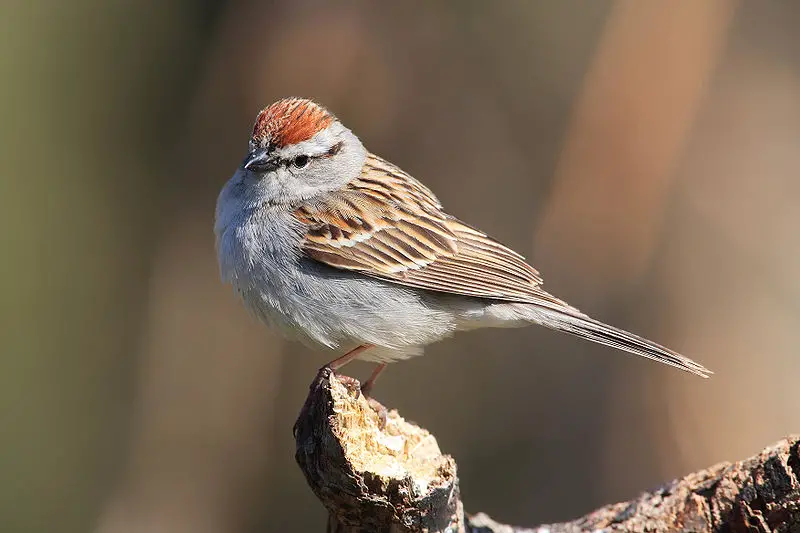
The Chipping Sparrow is a small passerine bird found across most of North America. It has two subspecies, the eastern and western chipping sparrows which migrate seasonally to overwinter in warmer climates.
The birds are grey above with white underparts, have a rufous cap with black stripes, and large eyes surrounded by light brown feathers.
They feed mainly on seeds but can also be seen eating insects during breeding season when raising their young chicks.
These intrepid little birds live in open grasslands such as prairies or meadows where they build cup-shaped nests in trees or shrubs to raise their young family.
Their cheerful song often sounds like ‘chips’ hence its name; Chipping Sparrow.
Scientific classification:
| Kingdom | Animalia |
| Phylum | Chordata |
| Class | Aves |
| Order | Passeriformes |
| Family | Passerellidae |
| Genus | Spizella |
| Species | S. passerina |
30. Red-Breasted Nuthatch

The Red-breasted Nuthatch is a beautiful and vocal songbird that can be found in coniferous forests across Canada, Alaska, the northeastern United States, and the western US.
This small bird has blue-grey upperparts with cinnamon underparts, a white throat and face with black eye stripe, a straight grey bill, and a black crown.
Its call sounds like a tin trumpet; it’s high-pitched yet nasal.
During mating season they form monogamous pairs to build their nest near tree trunks or branches at low heights off the ground where they lay 2 – 8 eggs at once.
They are very active little birds who love clinging to trees while searching for insect larvae or seeds within the bark of trees which helps control pest populations.
Scientific classification:
| Kingdom | Animalia |
| Phylum | Chordata |
| Class | Aves |
| Order | Passeriformes |
| Family | Sittidae |
| Genus | Sitta |
| Species | S. canadensis |
31. Blue-Gray Gnatcatcher
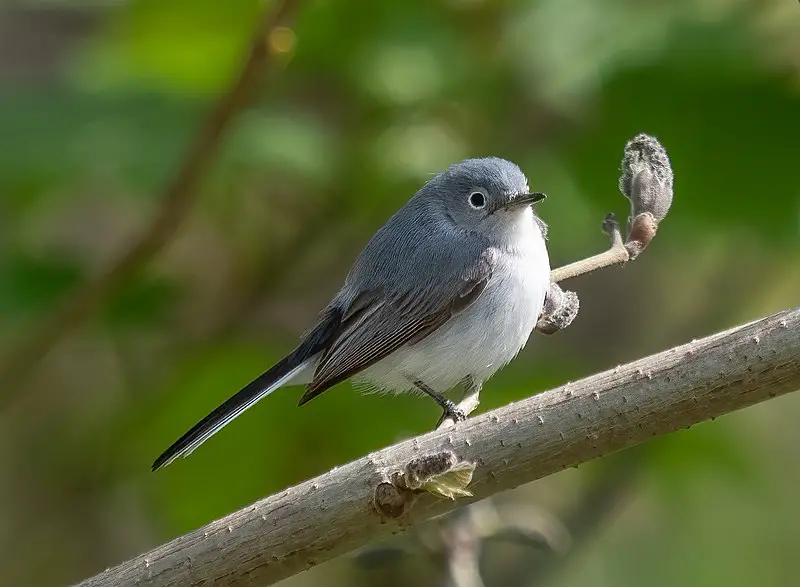
The Blue-gray Gnatcatcher is a beautiful small songbird native to North America. It has a length of 10–13 cm (3.9–5.1 in), a wingspan of 6.3 in (16 cm), and weighs only 5–7 g (0.18–0.25 oz).
Males have blue-gray upperparts with white underparts, slender dark bills, and long black tails edged in white; females are less vibrant but still eye-catching.
Juveniles are brownish-gray overall but may show some hints of adult coloration around their tails or shoulders as they mature into adulthood.
Their diet consists mainly of insects which they catch while flitting through air like tiny darts.
This stunning species can be found anywhere from woodlands to urban parks so keep your eyes peeled for these delightful creatures on your next outdoor adventure.
Scientific classification:
| Kingdom | Animalia |
| Phylum | Chordata |
| Class | Aves |
| Order | Passeriformes |
| Family | Polioptilidae |
| Genus | Polioptila |
| Species | P. caerulea |
32. Common Yellowthroat

The Common Yellowthroat is a small, New World Warbler found throughout North America. It has distinctive yellow and black plumage that earned it the nickname “Yellow Bandit” in the Midwest United States.
This species is highly adaptable and can be found inhabiting wetlands, grasslands, shrubland habitats, as well as suburban areas.
The genus of this bird’s scientific name translates to mean ‘ground’ and ‘small bird’, which are fitting characteristics for such an elusive yet common little creature.
Its diet consists predominantly of insects but may also include other invertebrates like spiders or worms.
Overall the Common Yellowthroat makes an excellent addition to any backyard with its cheerful song.
Scientific classification:
| Kingdom | Animalia |
| Phylum | Chordata |
| Class | Aves |
| Order | Passeriformes |
| Family | Parulidae |
| Genus | Geothlypis |
| Species | G. trichas |
33. Common Loon
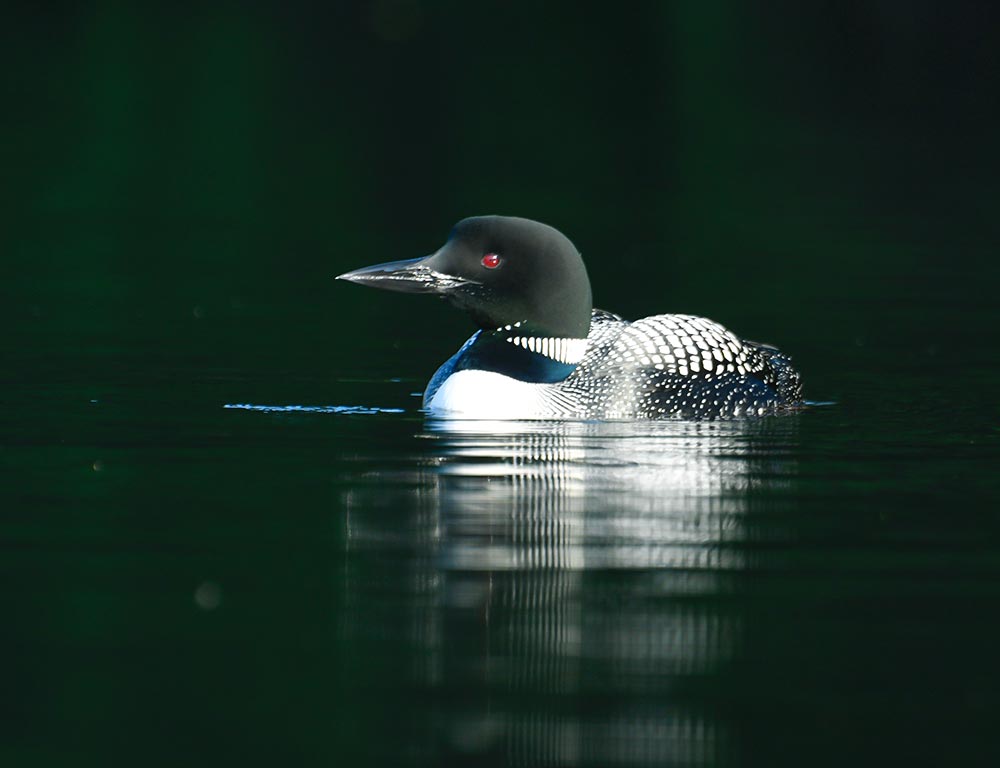
The Common Loon is a beautiful bird found in North America. It has a large black head and neck, with a greenish to purple sheen that stands out against its dark grey upperparts.
The underparts are pure white except for some black on the undertail cover and vent.
During non-breeding season adults have brown plumage instead of the bright shades they show during breeding season.
They also exhibit unique behaviors such as diving underwater to catch fish or swimming along lakeshores while calling loudly, which is how they got their name “great northern diver”.
With their stunning colors and interesting behavior, it’s no wonder why these birds make up an iconic part of many landscapes across North America.
Scientific classification:
| Kingdom | Animalia |
| Phylum | Chordata |
| Class | Aves |
| Order | Gaviiformes |
| Family | Gaviidae |
| Genus | Gavia |
| Species | G. immer |
34. House Wren
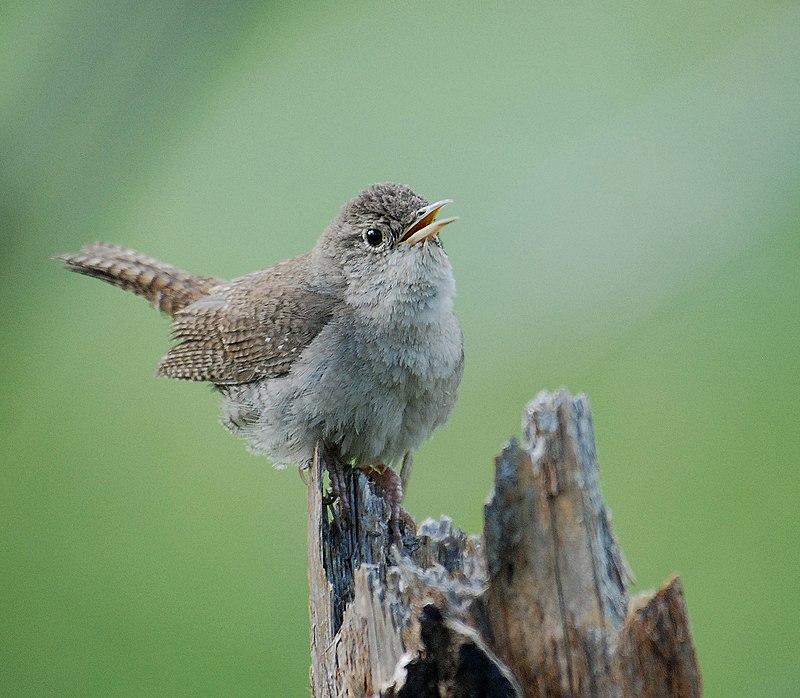
The House Wren is a small bird of the Wren family found from Canada to South America. It’s quite common in suburban areas and is one of the most widely distributed native birds in North and South America.
Its taxonomy can be complicated, with some subspecies groups considered separate species.
The House Wren has a brown back, grey head, white eyebrow stripes, light chestnut belly, and buffy flanks.
They often inhabit old or abandoned buildings as well as shrublands near fields or open woods for nesting sites.
During breeding season they are highly territorial so make sure you create an inviting environment if you wish to invite them into your yard.
Scientific classification:
| Kingdom | Animalia |
| Phylum | Chordata |
| Class | Aves |
| Order | Passeriformes |
| Family | Troglodytidae |
| Genus | Troglodytes |
| Species | T. aedon |
34. Sharp-Shinned Hawk
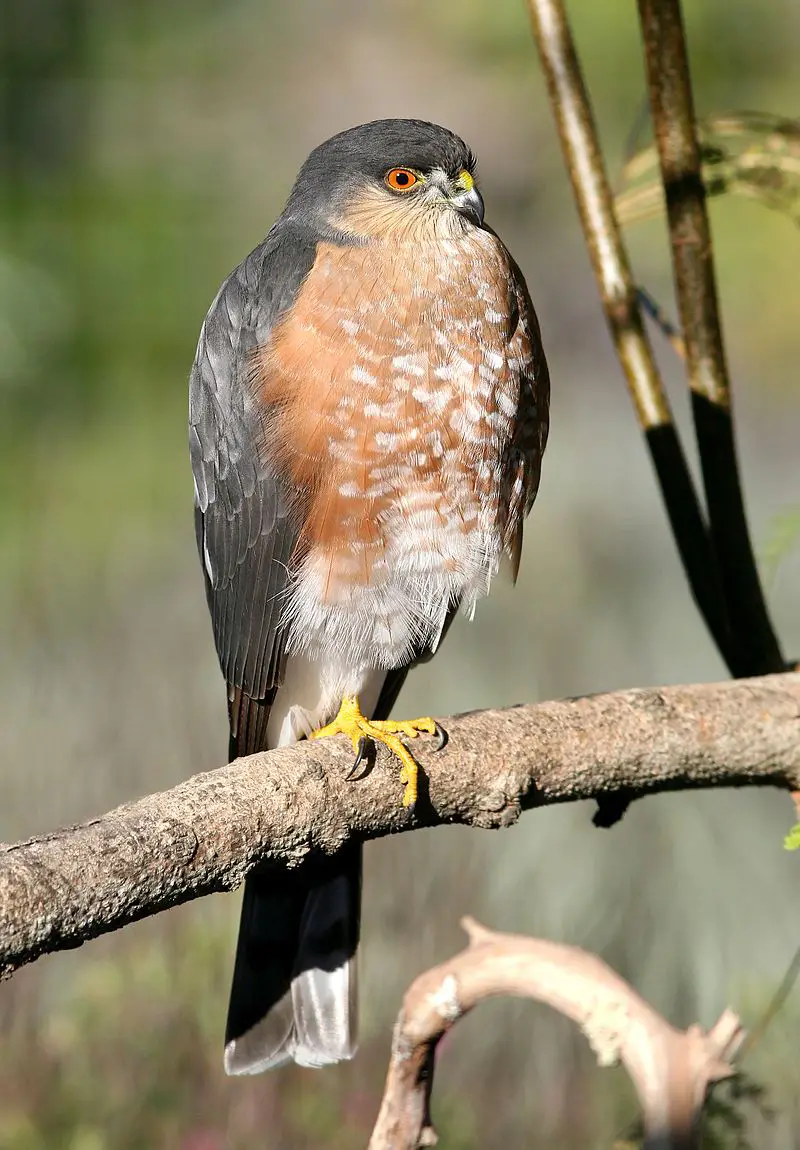
The Sharp-shinned Hawk is a small hawk found throughout the United States and Canada. It is one of the smallest hawks in North America, but larger than some Neotropical species such as the tiny hawk.
The taxonomy of this bird remains uncertain; with some authorities suggesting that southern taxa may represent three distinct species: white-breasted hawk (A. chionogaster), plain-breasted hawk (A. ventralis), and rufous morph sharp-shinnedhawk(A. rufiventris).
These birds feed primarily on small birds like finches, sparrows, woodpeckers, and warblers while hunting from perches or by flying through dense vegetation to surprise unsuspecting prey items.
They are agile flyers that rely heavily on surprise to capture their food items quickly before they can fly away.
Scientific classification:
| Kingdom | Animalia |
| Phylum | Chordata |
| Class | Aves |
| Order | Accipitriformes |
| Family | Accipitridae |
| Genus | Accipiter |
| Species | A. striatus |
35. Snow Bunting
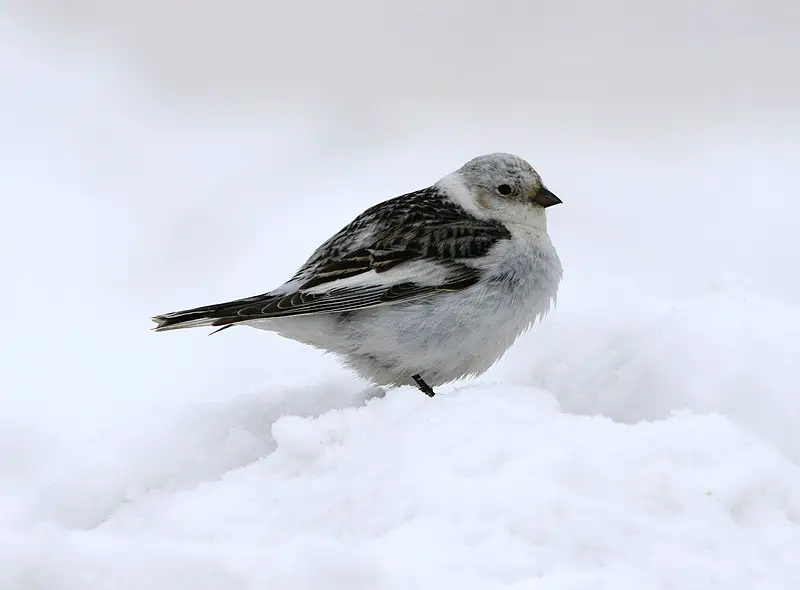
The snow bunting is a small and colorful passerine bird found in the Arctic regions of the northern hemisphere.
With its bright white feathers and black markings on its wings and tail, it stands out amongst other birds that inhabit these cold climates.
This species has adapted well to surviving in this harsh environment; they nest under boulders or rocks so their eggs are shielded from predators and blizzards alike.
They feed mainly on insects during summer months but switch to seeds when winter arrives as they seek food sources that will not freeze over with ice.
The Snow bunting is an important part of the local ecosystem due to providing sustenance for larger animals such as foxes and owls who rely upon them for survival throughout wintertime.
Scientific classification:
| Kingdom | Animalia |
| Phylum | Chordata |
| Class | Aves |
| Order | Passeriformes |
| Family | Calcariidae |
| Genus | Plectrophenax |
| Species | P. nivalis |
36. Tundra Swan
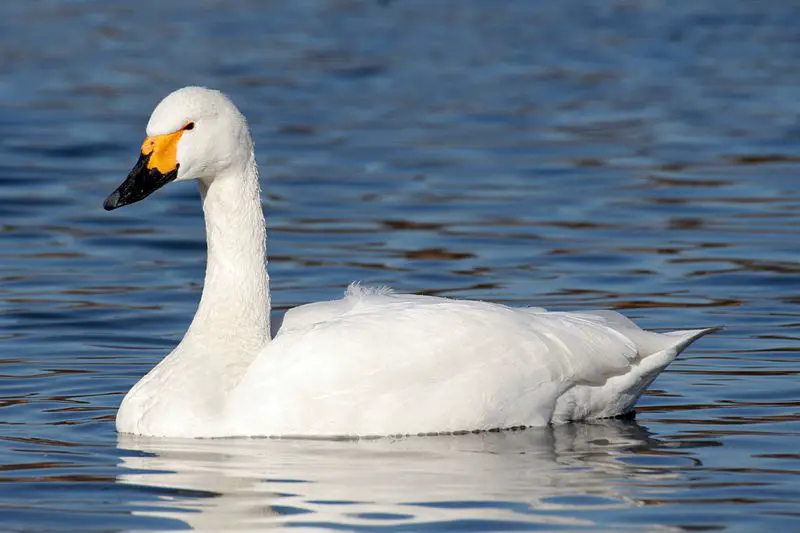
The Tundra swan is a small species of swan found in the Holarctic region. It can be divided into two separate taxa, Bewick’s Swan and Whistling Swan.
The former inhabits the Palearctic area while the latter resides near North America.
These birds are typically white with black bills and eyes but their legs vary from yellow to greyish-black depending on which subspecies they belong to.
They feed mainly on aquatic plants such as algae, roots, tubers, and various types of seeds.
During migration, these birds fly together in large flocks that may contain hundreds or even thousands of individuals at one time.
This majestic bird is an important part of many wetland ecosystems around the world where it plays a vital role in controlling vegetation growth as well as dispersing nutrients across its habitat range.
Scientific classification:
| Kingdom | Animalia |
| Phylum | Chordata |
| Class | Aves |
| Order | Anseriformes |
| Family | Anatidae |
| Genus | Cygnus |
| Species | C. columbianus |
37. Piping Plover
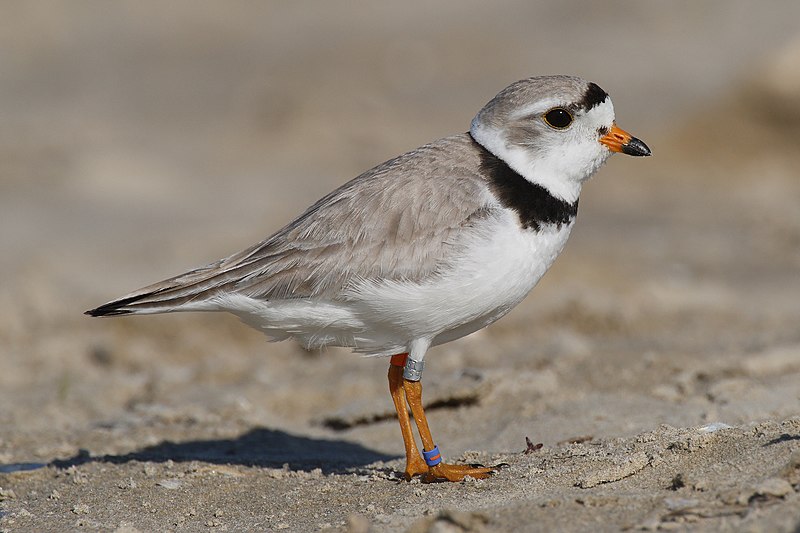
The Piping Plover is a small shorebird that can be found along sandy or gravel beaches in North America.
It has yellow-orange-red legs and its distinctive features include a black band across the forehead from eye to eye, as well as a thicker chest band for males during breeding season.
They are threatened by human activity in their habitats such as the increasing development of coastal areas, the destruction of their nesting sites due to recreation activities like beach driving and off-leash dogs.
Conservation efforts aim at protecting these birds through habitat protection measures including fencing off areas where they nest and restricting access during breeding seasons.
The future looks brighter with conservation initiatives by local governments slowly bringing the population up again over time.
Scientific classification:
| Kingdom | Animalia |
| Phylum | Chordata |
| Class | Aves |
| Order | Charadriiformes |
| Family | Charadriidae |
| Genus | Charadrius |
| Species | C. melodus |
38. Cattle Egret
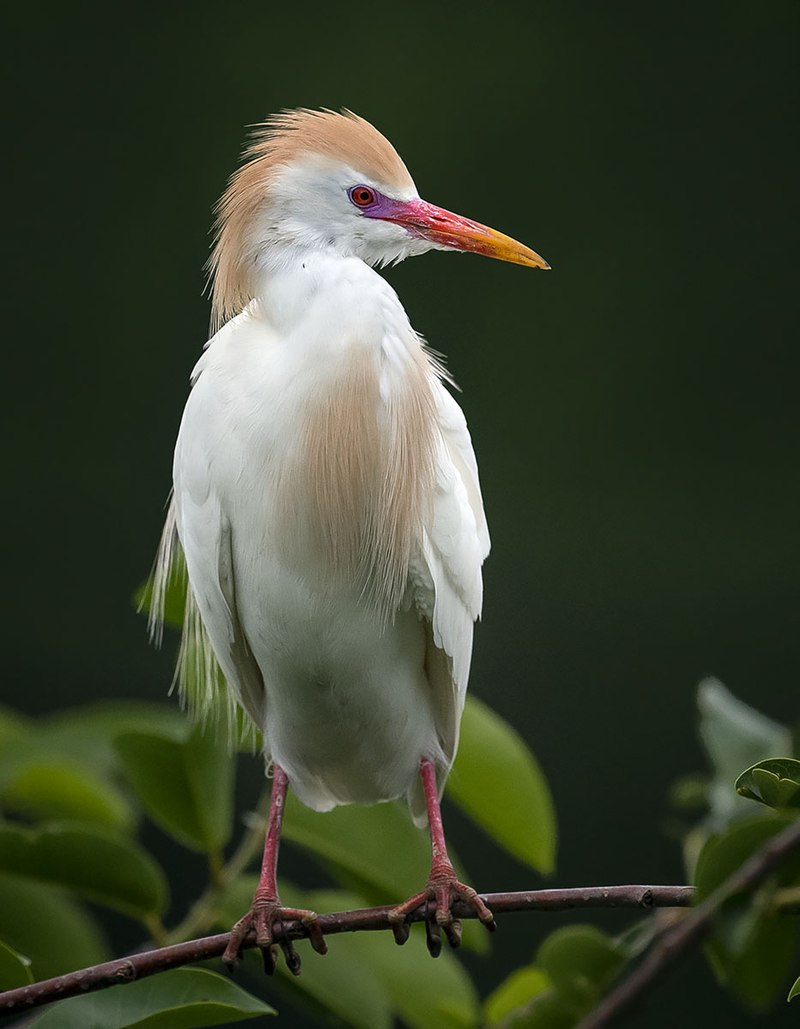
The Cattle Egret is a heron of the family Ardeidae found around the world in tropical, subtropical, and warm temperate areas. It has two subspecies: western cattle egret and eastern cattle egret.
They have white plumage with buff plumes on their head, neck, and back. The beak is yellowish-orange with a black tip while the legs are orange or yellow coloured depending on species variation.
This bird usually feeds near large herds of animals such as cows, horses, etc, where it finds plenty of insects to eat like grasshoppers, crickets, etc.
Its presence benefits these animals by removing ectoparasites from them which leads to a healthier livestock population.
It nests colonially in trees or shrubs located close to water bodies during breeding season which generally takes place between March and June every year.
Scientific classification:
| Kingdom | Animalia |
| Phylum | Chordata |
| Class | Aves |
| Order | Pelecaniformes |
| Family | Ardeidae |
| Genus | Bubulcus Bonaparte, 1855 |
| Species | B. ibis |
39. Great Egret

The Great Egret is a large, white bird found in many regions of the world. It has four subspecies that reside across Asia, Africa, the Americas, and southern Europe.
This species usually lives near bodies of water such as lakes and marshes. They are also now starting to spread into more northern areas of Europe due to climate change.
These birds have long yellow legs with an impressive wingspan for their size which allows them to soar majestically through the sky hunting for fish or amphibians in shallow waters below.
Their feathers have been used historically by Native Americans as part of traditional garments or ceremonies but this practice should be avoided today so these amazing creatures can thrive without harm from humans.
Scientific classification:
| Kingdom | Animalia |
| Phylum | Chordata |
| Class | Aves |
| Order | Pelecaniformes |
| Family | Ardeidae |
| Genus | Ardea |
| Species | A. alba |
40. Eastern Kingbird
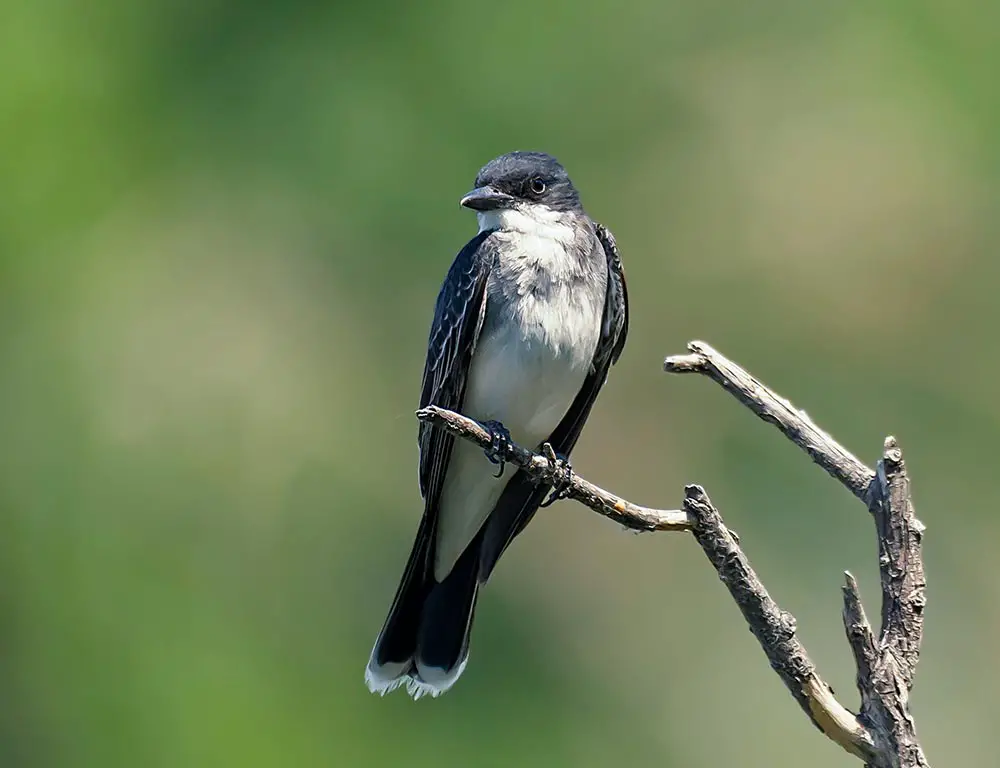
The Eastern kingbird is an impressive large grey bird, with a white underbelly and pointed wings. It can be seen perched atop trees or bushes in open areas while foraging for insects.
This species of tyrant flycatcher breeds across much of North America during the spring and summer months before migrating southwards come wintertime.
During this time, they have been known to travel as far south as Central and South America.
These birds are particularly territorial when nesting; having been observed chasing off even larger animals such as hawks away from their nests. A truly remarkable sight to behold.
Scientific classification:
| Kingdom | Animalia |
| Phylum | Chordata |
| Class | Aves |
| Order | Passeriformes |
| Family | Tyrannidae |
| Genus | Tyrannus |
| Species | T. tyrannus |
To Recap
Rhode Island boasts a remarkable array of 51 bird species, each contributing to the state’s natural beauty and ecological balance.
From the iconic Rhode Island Red chicken to the majestic Osprey and the delicate Eastern Bluebird, these avian residents and migrants enhance the state’s biodiversity.
Birdwatchers and nature enthusiasts are treated to a diverse range of sightings throughout the year.
Protecting the habitats and ecosystems that support these birds is paramount to ensuring their continued presence in Rhode Island.
As stewards of this natural heritage, it is our responsibility to appreciate, conserve, and cherish the rich avian diversity that graces the state.